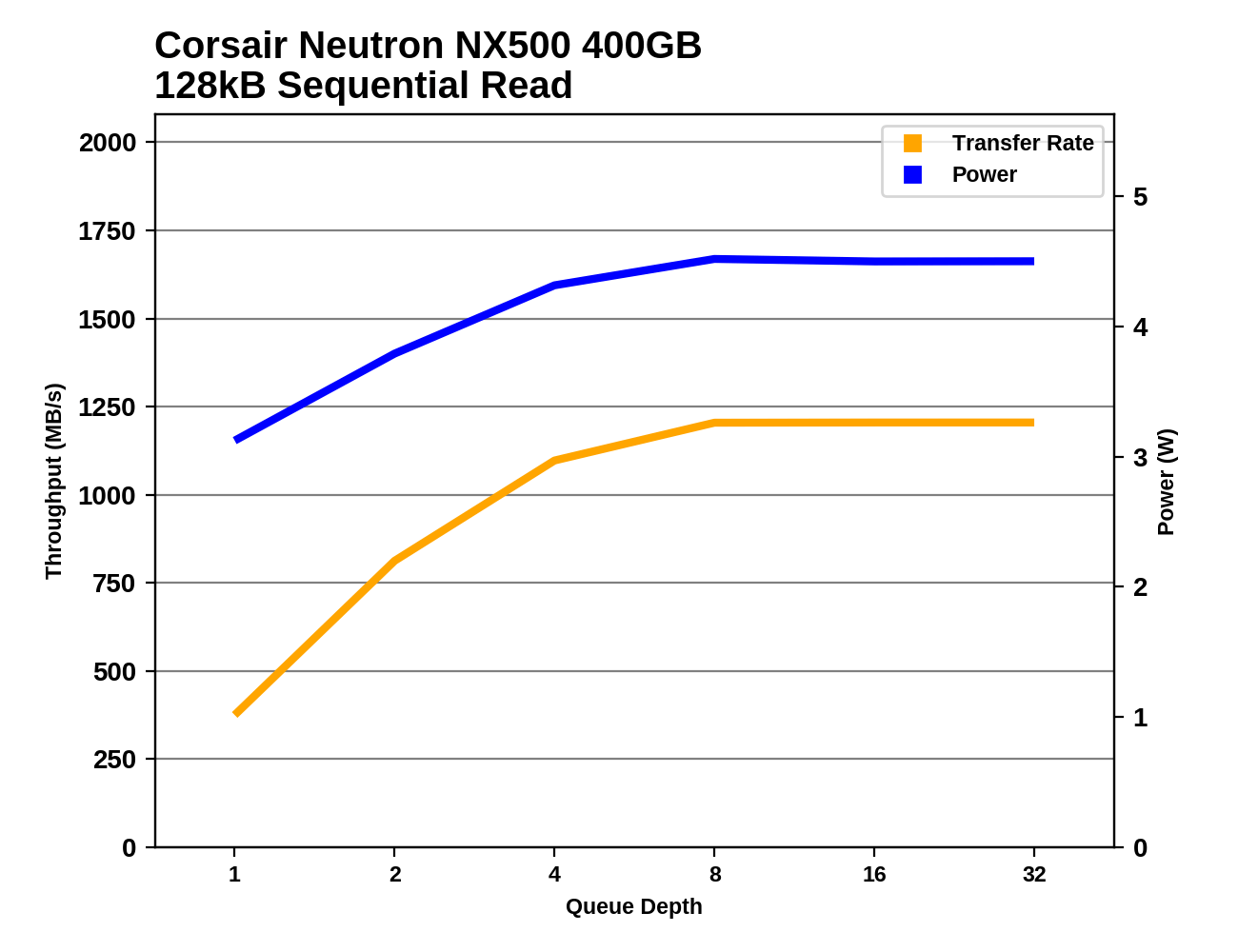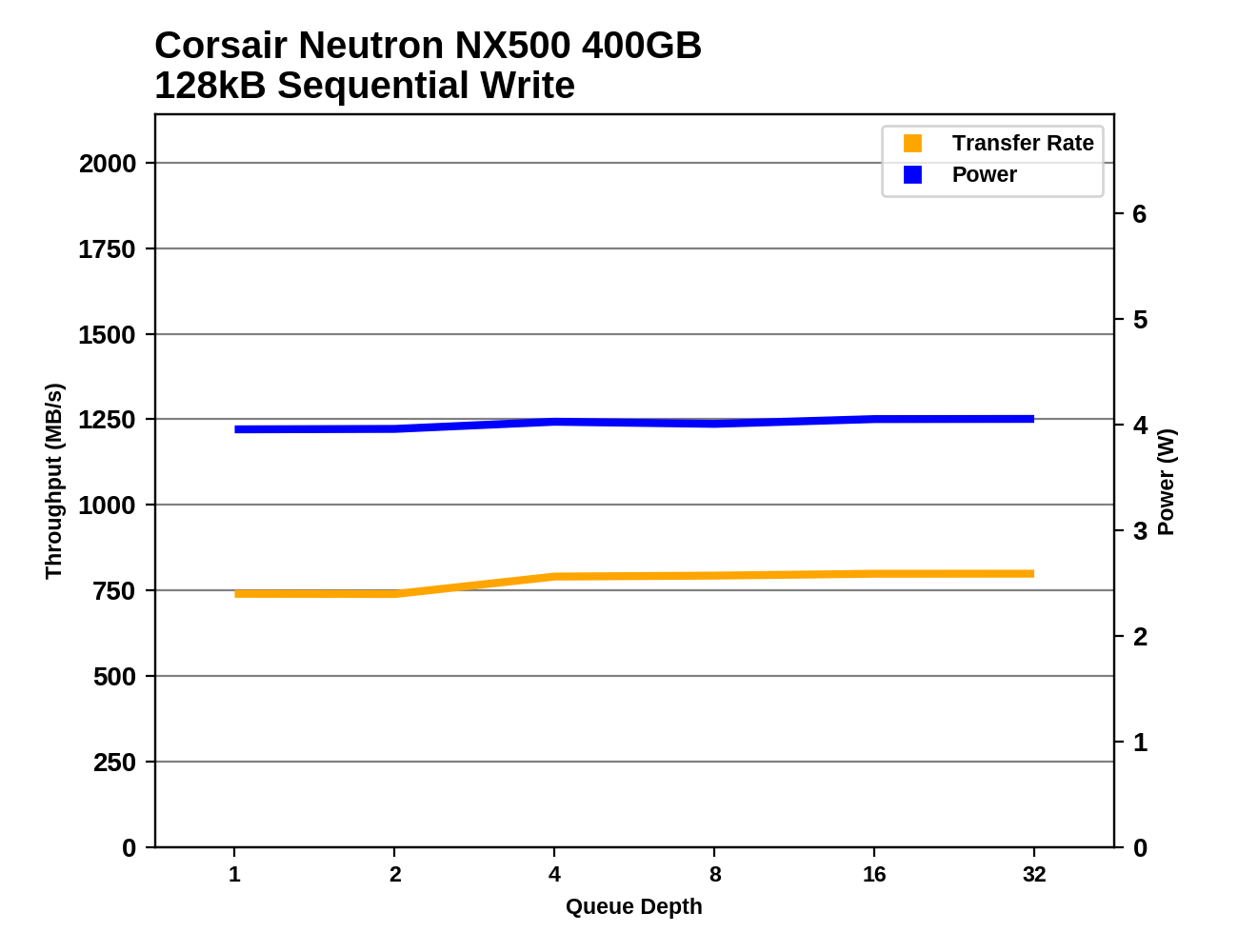The Corsair Neutron NX500 (400GB) PCIe SSD Review: Big Card, Big Pricetag
by Billy Tallis on August 16, 2017 10:00 AM ESTSequential Read Performance
Our first test of sequential read performance uses short bursts of 128MB, issued as 128kB operations with no queuing. The test averages performance across eight bursts for a total of 1GB of data transferred from a drive containing 16GB of data. Between each burst the drive is given enough idle time to keep the overall duty cycle at 20%.

The QD1 burst sequential read speed of the Corsair Neutron NX500 is a bit slower than the Patriot Hellfire, and quite a bit slower than the Plextor M8Pe. The Samsung NVMe drives are in a completely different league with QD1 read speeds more than twice as fast as any competitor.
Our test of sustained sequential reads uses queue depths from 1 to 32, with the performance and power scores computed as the average of QD1, QD2 and QD4. Each queue depth is tested for up to one minute or 32GB transferred, from a drive containing 64GB of data.

In the longer test that includes some higher queue depths, the NX500's sequential read speed is respectable and basically tied for the fastest non-Samsung drive in the bunch. It is also clearly faster than the other two Phison E7 drives.

The power efficiency of the NX500 during sequential reads is the best among the NVMe SSDs using planar NAND, and the other two Phison E7 drives follow the NX500 in the rankings. Samsung and Toshiba's 3D NAND NVMe drives offer much higher power efficiency.
 |
|||||||||
From QD1 speeds barely faster than a SATA link and half as fast as most NVMe competition, the NX500 eventually scales up to a decent saturation speed of around 1.2GB/s at QD8 or higher. Unfortunately, Samsung delivers better performance than this even at QD1, though the 960 EVO only barely so, and the 500GB version might not be quite as fast.
Sequential Write Performance
Our test of sequential write burst performance is structured identically to the sequential read burst performance test save for the direction of the data transfer. Each burst writes 128MB as 128kB operations issued at QD1, for a total of 1GB of data written to a drive containing 16GB of data.

The Corsair Neutron NX500's burst sequential write speed is the slowest of the three Phison E7 drives, but only barely and the performance is still decent for a planar NAND drive.
Our test of sustained sequential writes is structured identically to our sustained sequential read test, save for the direction of the data transfers. Queue depths range from 1 to 32 and each queue depth is tested for up to one minute or 32GB, followed by up to one minute of idle time for the drive to cool off and perform garbage collection. The test is confined to a 64GB span of the drive.

With a longer test, the Phison E7 drives hold on to their rankings though the NX500 is still the slowest of the three by a hair. Samsung's drives offer far higher sequential write speeds, but the rest of the competitors are clearly slower than the NX500.

The NX500's power efficiency during sequential writes is a bit worse than the Patriot Hellfire, but otherwise it is only beat by Samsung's NVMe drives. The next most efficient drive is the Toshiba XG5, which like Samsung's drives has the benefit of 3D NAND.
 |
|||||||||
The performance and power consumption of the Corsair Neutron NX500 during sequential writes barely changes with queue depth. The Samsung 960 EVO 1TB is more than twice as fast at QD2 or higher, so it is a very safe bet that even the 500GB version of the 960 EVO would have a significant advantage over the NX500 here.










45 Comments
View All Comments
Kristian Vättö - Wednesday, August 16, 2017 - link
There are numerous 8-lane enterprise SSDs already.hlm - Wednesday, August 16, 2017 - link
e.g. HGST FlashMAX III and HGST Ultrastar SN260 products are eight-lane devices.The_Assimilator - Wednesday, August 16, 2017 - link
Hey look, another SSD that has no reason whatsoever to exist!I don't understand why manufacturers don't, y'know, try to COMPETE with Samsung instead of re-re-releasing the same old, tired, slow controllers with slightly different but ultimately insignificant spins on them.
DanNeely - Wednesday, August 16, 2017 - link
Because unless you have a billion dollars to spend and a few years to wait, you can't create your own controller. That means almost all of the other companies selling drives have to pick and choose between a handful of controllers made by Phison/etc. Until they recover from Samsung's blind siding them and design new higher performing architectures from the ground up none of them have anything in the same performance class. If what happened at the start of the market when Intel's controllers were unbeatable is any indication we should hopefully have competitive designs available in another year or so.FunBunny2 - Wednesday, August 16, 2017 - link
-- Because unless you have a billion dollars to spend and a few years to wait, you can't create your own controller.well, isn't a controller an implementation of physics and math? which is to say, unless something new happens with NAND chips (not just node size or xLC), may haps we've reached the one-true-answer to the controller problem? may be there's just no more there, there.
Samus - Wednesday, August 16, 2017 - link
Wow. That was disappointing.RaistlinZ - Wednesday, August 16, 2017 - link
Current Newegg Prices:1. 500GB Samsung 960 Pro = $299.99
2. 1TB Samsung 960 Pro = 600.82
The NX500 has no reason to exist. The price needs to be cut in half to make it even REMOTELY attractive.
alpha754293 - Wednesday, August 16, 2017 - link
I'm surprised you didn't bother comparing it against the Intel 750 Series 400 GB PCIe NVMe SSD.Billy Tallis - Thursday, August 17, 2017 - link
I had originally planned to include the 400GB 750, but some of the results from it looked funny and I decided it wasn't worth postponing the review for several days to re-test the 750. That drive's a pain to test, because I have to run each test twice in order to record the power on both the 3.3V and 12V lines, and the performance has to match between the two runs for the results to be valid.alpha754293 - Friday, August 18, 2017 - link
Depending on how you want to tackle/handle it.There are statistical methods available out there that even with noisy data (e.g. high standard deviations) that you can still use it to process data that might otherwise not make sense at first glance, on the surface.
Course, that would also mean that care would need to be taking so that the tests in and of itself are repeatable.
I only mention it because I would be VERY interested to see how this compared to the Intel 750 series.
Thanks.